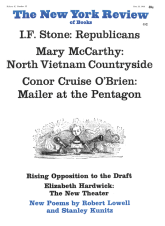In response to:
Portrait of the Artist as a Middle-Aged Adulterer from the February 29, 1968 issue
To the Editors:
Matthew Hodgart’s perceptive review of Giacomo Joyce (February 29, 1968) contains a suggestion that the hallucinatory passage on Page 15 was written after Joyce moved to Paris in 1920, and was not in fact hallucinatory but realistic, referring to a later love affair. This theory won’t work because:
- It would mean that a visit from Oliver Gogarty depicted in the passage actually took place after the early chapters of Ulysses had been published in magazines. No such meeting is recorded, and Gogarty’s own testimony was that he last met Joyce in 1909. If it had occurred, it would have been of great significance to both men, and somebody would have mentioned it. Gogarty’s appearance must therefore be phantasmic, and the chances are very good that the rest of the passage is of the same stuff.
- If Joyce had written this passage into Giacomo Joyce in Paris, he would have had to send the manuscript back to Trieste to his brother, among whose effects it was found. But from the time Joyce left Trieste, in 1920, he and his brother were not on the best of terms, and such exchanges of Joyce’s papers as took place all went from Trieste to Paris, not the other way. It seems incredible that Joyce, who didn’t even take some of his notes for later chapters of Ulysses with him, would have carried Giacomo Joyce to Paris, entered one passage in it, and then sent it back to Trieste.
-
Mr. Hodgart suggests that the passage may refer to Marthe Fleischmann, whom Joyce knew in Zurich in 1918-19. But the “husband” mentioned in the passage is then left dangling, since Joyce was well aware that Fräulein Fleischmann was unmarried.
The likelier assumption is that the whole passage is hallucinatory, like the climactic episode (Circe) of Ulysses. Just as Circe culminates in a black mass, made up of details introduced earlier without satanic inflection, so Paris (presented on page 10 of Giacomo Joyce in a Good Friday mass at Notre Dame) is here hallucinated as a tawdry, narrow room with infernal serpent and fire. Giacomo’s dream calls up a scene later in time, when his pupil would be married and full of unexpectedly progressive sexual notions (“adultery of wisdom,” he calls them) as well as of infernal designs upon him. As the notion of being fatally involved with her grips him, he wakes, with the cry “Nora!”, to reality and marital reassurance.
This dream contrasts with one Joyce reported to Herbert Gorman, in which Molly Bloom—also posed later in time—tossed a coffinlike snuffbox at him, saying, “And I have done with you, too, Mr. Joyce,” while Ezra Pound (instead of Gogarty) stood by. Molly rejects him, while Giacomo’s pupil is fearfully about to seduce him. As in one of his epiphanies, Joyce feared yet cried “for an iniquitous abandonment,” and made the possibility of it the scene of greatest tension in Ulysses as earlier in Giacomo Joyce.
Richard Ellmann
Northwestern University
Evanston, Illinois
This Issue
June 20, 1968



